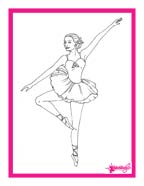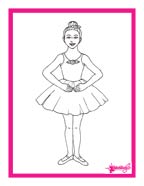Coloring Pages
Dance Dictionary
Excerpted from The Language of Ballet by Thalia Mara
Arabesque (ah-rah-besk): A long flowing line made by arching the body and balancing it over one foot with the other leg extended behind. The arms extend the pose to make the longest possible line from fingertips to toe tips.
Chasse, pas (pah shah-say): Literally, chasing step. One foot seems to chase the other foot out of its position. A gliding step on the floor from a closed position to an open one.
Chasse (shah-say): A gliding step on the floor from a closed position to an open one.
Degage, pas (pah day-gah-zhay). Literally, disengaging step. A pointing of the fully arched foot to an open position.
Demi-Plie (d’mee-plee-ay): Literally, half bent. A half bending of the knees. The knees are bent only as far as is possible while still keeping the heels securely placed on the floor.
Jete, Pas (pah zhey-tay): Literally, step thrown, or throwing step. A jump from one foot to the other, performed with a throwing movement of the leg.
Pirouette (peer-oo-wet): Literally, whirl. A complete turn of the body on one foot, usually on the demi-pointe or pointe.
Plie (plee-ay): Literally, bent; bending. A bending movement of the knees.
Pointe tendue (pwahnt tahn-diu): Literally, point stretched. A term used to indicate that the foot is pointed; that is, the instep is stretched and the toes are pressed downward, the weight of the body being supported by the other foot.
Port de bras (por dih brah): Literally, carriage of the arms. The generic term for any movement of the arms in ballet.
Releve (rih-leh vay): Literally, relifted. A term used to indicate that the body is raised to the full point or half point during the execution of a step or movement.
Ron de Jambe (rohn dih zhahnb): Literally, circle of the leg.
Spotting: The technique of using the eyes in turning in order to prevent dizziness in multiple turns, to maintain the equilibrium of the body, and to give a quality of brilliance to the turn. The theory is to focus the eyes on a definite spot at eye level, to maintain this focus as the body begins to turn so that the head lags behind the body and then to turn the head rapidly before the body and refocus the eyes, almost instantly on the same spot, looking over the shoulder as the body completes the turn.

